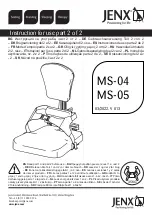
R Healthcare
Modular
User Guide
Page
10
August 2013 Revision E
www.rhealthcare.co.uk
1.5
Wheels
MAKE SURE TYRES ARE CORRECTLY
INFLATED TO 45 psi BEFORE USING THE WHEELCHAIR.
The R Healthcare Modular range is available with a wide choice of wheels and castors.
All Attendant Controlled chairs, i.e. those with small wheels, and some Occupant
Controlled chairs have wheels, which are permanently secured into the mounting block
unit by a screwed spindle.
Occupant Controlled chairs are available with QUICKLY DETACHABLE wheels. These
fit into a special receiver in the mounting block unit, and have a sprung loaded button
feature, to allow the user to remove them easily.
Versions fitted with Q.D. wheels provide the user
with an additional option to remove the wheels for
transit.
When the wheels are removed, the lifting weight
of the individual components is significantly
reduced, and we recommend their use when the
attendant person requires a little help in lifting the
chair.
When removing or replacing Q. D. wheels the brakes should be in the off position.
Depress the button in the centre of the hub and pull the wheel away from the
wheelchair. To replace the wheel, depress the button in the centre of the hub and
enter the wheel spindle into the mounting bush.
Ensure that the spindle is fully located by pulling
the wheel away from the wheelchair. Wheel
security is very important.
An occasional lubrication of the spindle will
ensure trouble free removal of the wheel.
The ONE ARM DRIVE version of the wheelchair
has a special rear wheel, which has two
handrims. The large outer handrim propels the
wheel to which it is attached. The smaller inner
handrim is connected via the wheel hub and
linkage to the wheel on the opposite side of the
wheelchair. The wheelchair is propelled by
alternately pushing on the outer and inner handrim. Occupants whose hands are large
enough may be able to push on both handrims at the same time.











































